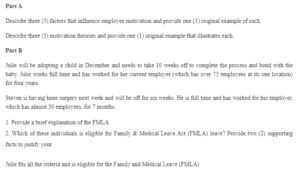Employee Motivation and FMLA Law
Three factors that influence employee motivation are effective leadership, money, and stability. In most cases, it is sad to say that money genuinely is the most significant influencing factor to employee motivation and is used as a motivational tool in many successful businesses; a successful means of using money as a motivational tool is highly recognized in sales the more an employee/associate can sell the more money they can make on commission. Money as a leading tool within a company can be highly beneficial in motivating the entire team because, let’s face it, no one ever brags about how much they sell or how well they are doing. In my experience, one of the most effective ways to use money for motivation includes promotions through a succession plan; if an employee completes specific requirements required to be promoted, money follows with the rise and responsibility. In an ideal world, the more employees make within a company, the more the company makes.
Perhaps, if not equally important, more significant in motivating employees, in my opinion, is the effectiveness of leadership and their ability to influence employee motivation. A leader can have employee motivation, retention, productivity, succession, and many other attributes that make a company successful. An effective leader helps stimulate employees towards goal setting and enables them to meet goals, providing a sense of accomplishment, pride, and, more importantly, ownership. When employees have a sense of ownership in their actions, motivations will more often follow it.
The ability to influence employee motivation is another excellent way to motivate. Strength in the workforce translates to job security. A great example of this is that military service members are encouraged to do more than many can ever imagine due to the stability of the job. If an employee/person has job stability, then in many ways, that is one less thing they have to worry about, and they will inherently be more motivated to protect that.
The three motivation theories include Maslow’s, Herzberg’s, and Locke’s theory. Comparing Maslow’s theory with Herzberg’s, Maslow’s theory is known to be organized in a hierarchy or just from the most important to the least important (based on the order of human needs). At the same time, Hertzberg referred to hygiene and motivation factors. The hygiene factors are always dissatisfying, whereas motivation factors tend to motivate subordinates (Werner, 2012). Locke’s motivational theory is identified as the theory that treats goal setting and feedback as equally important.
The Maslow’s theory involves the team’s motivation in satisfying the five needs, while Locke’s theory motivates only two conditions. Identifying the application of the idea, Maslow’s theory is known to be the most popular and widely applied in motivation and has broad applicability. Herzberg is undoubtedly known as an extension of the Maslow’s theory of motivation; hence, its relevance is narrow (Brooks, 2007). The similarity between Maslow and Herzberg is that both approaches do not consider diversity among the workers in the structure of the idea.
FMLA Law
Based on the current FMLA law. According to the United States Department of Labor, FMLA provides certain employees up to 12 weeks of unpaid, job-protected leave per year. It also requires that their group health insurance be maintained during the break. FMLA applies to all public and private elementary and secondary schools and companies with 50 or more employees. The 12 weeks of unpaid can be used for placement with the employee of a child for adoption or foster care. Employees are eligible for leave if they have worked for their employer for at least 12 months, at least 1,250 hours over the past 12 months, and work at a location where the company employs 50 or more employees within 75 miles.
Based on the FMLA laws, neither Steven nor the company he works for is eligible for FMLA. Steven should investigate his company’s Health Insurance if purchased, and State Family Leave laws as they apply to small businesses. If neither of these pans out, he would have to use a combination of sick leave and personal leave or, if the company allows, donated leave.
References
Durr, E. (2018, August 31). US Army. Retrieved from American Soldiers during World War I: https://www.army.mil/article/210420/worldwide_flu_outbreak_killed_45000_american_soldier s_during_world_war_i
Storey, J. (2015). New perspectives on human resource management. Retrieved from file:///C:/Users/dtalon1983/Downloads/9781315740560_googlepreview.pdf.
ORDER A PLAGIARISM-FREE PAPER HERE
We’ll write everything from scratch
Question
Part A
Describe three (3) factors that influence employee motivation and provide one (1) original example of each.
Describe three (3) motivation theories and provide one (1) original example that illustrates each.

Employee Motivation and FMLA Law
Part B
Julie will be adopting a child in December and needs to take ten weeks off to complete the process and bond with the baby. Julie works full time and has worked for her current employer (over 75 employees at its one location) for four years.
Steven has knee surgery next week and will be off for six weeks. He is full-time and has worked for his employer, which has almost 30 employees, for seven months.
- Provide a brief explanation of the FMLA.
- Which individuals are eligible for Family & Medical Leave Act (FMLA) leave? Provide two (2) supporting facts to justify your
Julie fits all the criteria and is eligible for the Family and Medical Leave (FMLA)

